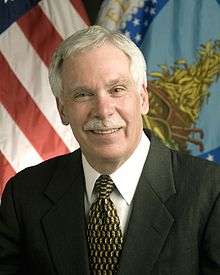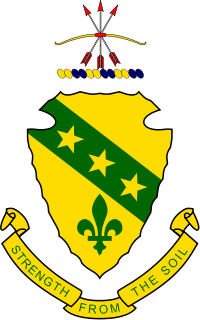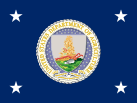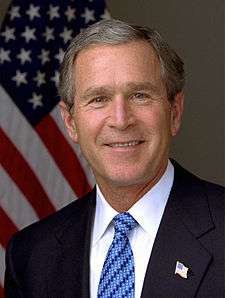Ed Schafer
| Ed Schafer | |
|---|---|
 | |
| 29th United States Secretary of Agriculture | |
|
In office January 28, 2008 – January 20, 2009 | |
| President | George W. Bush |
| Preceded by | Mike Johanns |
| Succeeded by | Tom Vilsack |
| 30th Governor of North Dakota | |
|
In office December 15, 1992 – December 15, 2000 | |
| Lieutenant | Rosemarie Myrdal |
| Preceded by | George Sinner |
| Succeeded by | John Hoeven |
| Personal details | |
| Born |
Edward Thomas Schafer August 8, 1946 Bismarck, North Dakota, United States |
| Political party | Republican |
| Spouse(s) | Nancy Jones Schafer |
| Children |
Tom Schafer Ellie Schafer Eric Jones (stepson) Kari (Jones) Hammer (stepdaughter) |
| Alma mater |
University of North Dakota University of Denver |
| Religion | Episcopalian (currently attends First Lutheran Church in Fargo, ND where his wife is a member.) |
Edward Thomas "Ed" Schafer (born August 8, 1946) is a business leader, former Governor of North Dakota, former U.S. Agriculture Secretary and past university administrator from North Dakota, United States. Shafer was elected twice and served as the 30th Governor of North Dakota, holding office from 1992 to 2000. Shafer served as the 29th United States Secretary of Agriculture from 2008 to 2009, appointed by President George W. Bush. He was appointed as the Interim President of the University of North Dakota, serving from January through June 2016.[1]
Early Life, Education and Family
Schafer was born and raised in Bismarck, North Dakota, and is the son of Marian Nelsen and businessman Harold Schafer. He is of German descent.[2] He has one sister, Pamela (Pam).
Shafer attended the University of North Dakota, where he earned a bachelor's degree in 1969. He pledged and became a member of Sigma Nu fraternity while an undergraduate. His M.B.A. degree was obtained from the University of Denver in 1970.[3]
The former Nancy Jones is Shafer's wife. Together, they have two children: Thomas "Tom" Schafer and Ellie Schafer. Shafer has two stepchildren: Eric Jones and Kari (Jones) Hammer.[4]
His sister, Pam Schafer, was the first wife of former Democratic-NPL U.S. Senator Kent Conrad.[5]
Golden Seal Company
Shaffer took a full-time job after graduation with his family's firm, the Gold Seal Company. Gold Seal North Dakota-based manufacturing company founded and owned by his father, Harold Shafer, in 1942.
Golden Seal was the distributor of "Mr. Bubble" bubble bath, "Glass Wax" glass cleaner and "Snowy Bleach." [6]
Ed Shafer rose through the ranks at Golden Seal, working in several divisions of the company. Eventually, he served as company president from 1978 to 1985. At its height, Golden Seal generated more than $50 million in annual revenues, which made it one of North Dakota's largest privately-held firms.[7]
Junkyard Wars engineering game show TV competition
Ed Shafer has had a long-time interest in building machinery and equipment from used, scrap materials.
Shafer was selected as a contestant on the Discovery Channel's engineering game show Junkyard Wars, when his team worked to build a machine from junked components.[8]
In 2003, Schafer was seen competing during the fifth season of the show, when he also served as the captain of the "High Flyers" team. His team took 2nd Place in the competition, losing to the "Jet Doctors" in the Season Five finale.
Governor of North Dakota
Schafer was elected twice and served as the 30th governor of North Dakota, holding office from 1992 to 2000.[9]
Shafer is a Republican and a self-titled conservative.[10]
In 1990, Schafer unsuccessfully challenged then-U.S. Congressman Byron Dorgan as Dorgan ran for re-election. Shafer captured 35% of the vote, to 65% for the Dorgan, the Democratic candidate.
Shafer entered the North Dakota gubernatorial general election campaign of 1992 as the Republican nominee. He and the Republican candidate for lieutenant governor Rosemarie Myrdal were victorious over the Democratic candidate for governor, former Attorney General of North Dakota, Nicholas Spaeth and the Deomocratic candidate for lieutenant governor, Julie Hill. Shafer and Myrdal captured nearly 58% of the vote, compared to 41% for Spaeth and Hill.
Upon his inauguration, Shafer became the first North Dakota Governor to be married while in office.
When Shafer became chief executive, North Dakota was facing major budgetary and financial hurdles. This continued, on and off throughout his two terms. "As governor, Schafer had to deal with budget crunches during his eight years as state budget maker in the Capitol," according to the Bismarck Tribune.[11]
While governor, Shafer oversaw annual state budgets that exceeded $4.5 million and a state employee workforce of more than 12,000.[12]
Schafer made the expansion and diversification of North Dakota's economy a priority. For example, he worked with the private sector to expand the production and distribution of value-added agricultural products such as corn sweeteners and pasta.
During his time in office, he helped to build a closer trading relationship with China in concert with other North Dakota government officials, federal government trade specialists and private sector business leaders. These efforts assisted in the development of China into a primary export market for North Dakota's products and services in the 1990s.
As governor during the rise of the global internet and the internet's introduction to broader society, Shafer realized the need for internet access across North Dakota. Shafer worked with both government and business leaders, implementing various efforts "to upgrade North Dakota's communications infrastructure and make high-speed voice and data networks available to farmers, ranchers and rural businesses", and to individual households.[13]
In 1995, Schafer served as Chair of the Midwestern Governors Association.
When Governor Shafer ran for reelection in 1996, he and Lt. Gov. Rosemarie Myrdal defeated Lee Kaldor, the Democratic gubernatiorial candidate and Barbara Pyle, the Democratic candidate running for Lieutenant Governor. Shafer and Myrdal received about two-thirds of the total votes in the general election.
Shafer's long-held interest in conservation led him to help arrange the U.S. Forest Service's May 2007 purchase of the 5,200 acre Elkhorn Ranch in North Dakota, while Shafer was Governor.[14] The Elkhorn Ranch was established by former United States president Theodore Roosevelt as his main working ranch in the North Dakota Badlands, and is now protected as a unit of the Theodore Roosevelt National Park.
In 1999-2000, during the final portion of his second term, Shafer served as Chair of the Republican Governors Association.
He did not seek reelection for Governor in 2000.
Work Life & Political Activities in the 2000s
Schafer was co-founder and CEO of Extend America, a start-up wireless communications company he founded after leaving office as Governor.
In 2002, Schafer was appointed as Civilian Aide to the United States Secretary of the Army.
Shafer acted as a frequent guest host of the "Hot Talk" radio program on WDAY-AM in Fargo, North Dakota.
Prior to his appointment to the cabinet, Schafer also served as an advisor and occasional spokesperson for the North Dakota chapter of Americans for Prosperity, a nationwide limited-government/pro-growth organization backed by the Koch Brothers.[15]
Ed Schafer became a supporter of the North Dakota Taxpayers' Association, serving as an advisor and a keynote speaker.
U.S. Secretary of Agriculture
In October 2007 Schafer was nominated by then-President George W. Bush to be the next Secretary of Agriculture.[16]
Shafer had wide support in the Senate. His hearing was originally scheduled for January 30, 2008, but was moved up on the request of North Dakota Senator Kent Conrad so that Schafer could attend the State of the Union address as a cabinet member.[17] That confirmation hearing was held on January 24,[18] with Senators asking Schafer questions on various topics such as US beef exports to Japan and South Korea, the Department of Agriculture's ability to deliver on programs passed by Congress, policy on sugar, and cotton prices.[19] On January 28, he was unanimously confirmed by the U.S. Senate. Later that same day, as Secretary of Agriculture, Shafer did attend the State of the Union Address with other members of the President's cabinet.[20]
Schafer was in office for less than two days when a major scandal erupted concerning animal cruelty and unsafe food practices by Hallmark/Westland Meat Packing Company, the nation's second-largest supplier of ground beef to the National School Lunch Program. The school lunch program is administered by the Department of Agriculture.
This led to the largest recall of meat in the history of the United States. The issues of how best to handle the problems of unsafe food practices and animal cruelty by USDA-inspected meat processing plants became a major focus of Shafer's administration.
The Humane Society of the United States received video showing multiple instances of workers abusing and torturing cattle who had fallen and were unable to walk into kill pens on their own, videographed in October and November 2007. The Humane Society, and many meat animal experts, ethicists and nutritionists objected to the use of downer cattle, or non-ambulatory cattle for human food, because of health, food safety - and because the cruelty showed ethical lapses on the part of Hallmark's management in over-seeing the behavior of their employees.
The company recalled massive quantities of beef and voluntarily shut down the plant where these videos were taken. According to the Cattlemen's Beef Promotions Board "The 143 million pound recall of beef from Hallmark/Westland Meat Packing Company triggered significant (media) coverage and renewed skepticism about the safety of the nation's beef supply and the competency of the U.S. Department of Agriculture (USDA)."[21]
At issue for USDA, under Shafer, and the Senate was whether these sick, injured and/or aged non-ambulatory cattle were safe for humans to eat.
In his February 28, 2008 testimony before the U.S. Senate Appropriations Subcommittee on Agriculture, Rural Development, Food and Drug Administration, and Related Agencies, Secretary Schafer indicated "that he would not endorse an outright ban on "downer" cows entering the food supply or back stiffer penalties for regulatory violations by meat-processing plants in the wake of the largest beef recall in the nation's history."[22]
Specifically, "the penalties are strong and swift, as we have shown," Schafer said. "Financially, I don't see how this company can survive. People need to be responsible and, from USDA's standpoint, they will be held responsible. . . . They broke the rules. That does not mean the rules are wrong. I believe the rules are adequate."[23]
Under Secretary Shafer's leadership, the Agriculture Department promised to improve animal welfare and human food safety. On August 27, 2008, USDA announced a proposed change in the rule regarding the treatment and handling of downer cattle. In a reversal of his February testimony to the Senate, Agriculture Secretary Ed Schafer indicated that "to maintain consumer confidence in the food supply, eliminate further misunderstanding of the rule and, ultimately, to make a positive impact on the humane handling of cattle, I believe it is sound policy to simplify this matter by initiating a complete ban on the slaughter of downer cattle."[24]
As Secretary Shafer predicted in his February 2008 Senate testimony, Hallmark/Westland Meat Packing Company subsequently went out of business.
Based in part on the initial work done by USDA personnel during Shafer's tenure as Agriculture Secretary, the U.S. Government sued Hallmark/Westland Meat Packing Company based on farm animal cruelty (to downer cattle), misrepresentation and fraud, winning a massive final judgement of $497 million.
This was the largest judgment ever entered for agriculture-related fraud and farm animal cruelty in federal court history. In this first-of-its-kind fraud case, the United States Department of Justice (DOJ) at the behest of USDA joined a lawsuit with the Humane Society of the U.S. against Hallmark/Westland Meat Packing Company. The lawsuit alleged that the Hallmark/Westland defrauded the federal government by violating and misrepresenting their compliance with the terms of their federal school lunch program contracts requiring the humane handling of animals.
A final judgement was entered in the case against defendant Hallmark Meat Packing Company in the amount of $497,000,000.00 in 2012 in favor of the DOJ. Yet that the majority of the $497 million was never recovered by the DOJ because of the company's bankruptcy and cessation of all business. The amount was reduced to $155 million as part of the final settlement with the remaining defendants. Part of the judgement amount was paid personally by company executives and members of the Hallmark family in structured settlements.[25][26]
These huge judgements and settlements in favor of the federal government were intended by the Department of Justice and the Department of Agriculture to deter future animal cruelty in and fraud by the nation's slaughterhouses.[27]
Interim President of the University of North Dakota
Ed Shafer was appointed as the Interim President of the University of North Dakota on November 9, 2016 by the Board of Higher Education. Among several dozen applicants for the interim office received by the state, Schafer stated he had no intent to apply to become the next permanent president.[28] Shafer signed a contract on December 2, 2015, to fill in for former University of North Dakota president Robert Kelley upon Kelley's retirement, which took place on January 14, 2016. This interim position Shafer accepted with "some hesitancy", he said.
Ed Shafer's appointment as Interim President of the University of North Dakota "did not sit well with a significant portion of the university faculty, according to the faculty representative on the Board of Higher Education." This lack of support by that portion of the University faculty was due in large part to the facts that Shafer did not possess an earned doctorate nor did he have any administrative experience in a research university, according to Eric Murphy, the Advisor to the North Dakota State Board of Higher Education. "The faculty voice is in opposition to" Shafer's selection as Interim President, Murphy said.[29] Shafer's working life was spent primarily in the realms of business and politics.
Despite his lack of academic leadership experience, Shafer became the highest-paid administrator in the state's entire higher education system history to that time. Shafer was paid $33,216 per month for his work that commenced on January 15, 2016 and continued through June 30, 2016.[30][31] Shafer's contract paid him $2,250 per month more than the retiring president, Robert Kelley, was earning after more than 7.5 years in that position.
Among the tasks Shafer inherited was overseeing the final stages of the Fighting Sioux naming issue that erupted over objections by the various tribes, ethnic groups and First Nation peoples identifying as Sioux, many other groups and thought leaders because of the University's use of the Sioux name and identity for its sports teams. On Shafer's first day as Interim President, the University's Graphic Identity RFP Evaluation and Recommendation Team met to begin reviewing the 16 proposals from design firms for a new logo design for the Fighting Hawks. Five months later, near the end of his interim term, Schafer revealed the new logo at a news conference on June 22, 2016, referring to the logo's debut as a "historic moment".[32]
On March 15, 2016, the selection of Mark Kennedy as the 12th president of the University of North Dakota was announced.[33] Kennedy's term began on July 1, 2016, succeeding Schafer.
Electoral history
- 1996 Race for Governor
- Ed Schafer (R) (inc.), 66%
- Lee Kaldor (D), 34%
- 1992 Race for Governor
- Ed Schafer (R), 58%
- Nick Spaeth (D), 41%
- 1990 Race for U.S. House of Representatives - At Large
- Byron Dorgan (D) (inc.), 65%
- Ed Schafer (R), 35%
References
- ↑ UPDATE: Schafer to serve as interim president at UND (Grand Forks Herald article-November 10, 2015)
- ↑ Brooke, James. . The New York Times. March 2, 1996. Retrieved December 10, 2012.
- ↑ http://und.edu/news/2016/01/ed-schafer.cfm
- ↑ http://www.usda.gov/wps/portal/usda/usdahome?contentidonly=true&contentid=bios_schafer.xml
- ↑ http://www.govexec.com/dailyfed/1007/103107cdpm2.htm
- ↑ http://www.bismarckcafe.com/blogs/wiki/gold-seal-company
- ↑ http://history.nd.gov/archives/manuscripts/inventory/31888.html
- ↑ "How 'Junkyard Wars' Works" 2 October 2002. HowStuffWorks.com. <http://entertainment.howstuffworks.com/junkyard-wars.htm> 4 September 2016
- ↑ http://www.usda.gov/wps/portal/usda/usdahome?contentidonly=true&contentid=bios_schafer.xml
- ↑ http://www.kfyrtv.com/content/news/Former-ND-Gov-Ed-Schafer-Endorses-Burgum-382139891.html
- ↑ http://bismarcktribune.com/news/opinion/editorial/columnists/disharmony-in-higher-education/article_f506496c-cbea-50a3-8a67-b956da1b67a5.html
- ↑ http://www.usda.gov/wps/portal/usda/usdahome?contentidonly=true&contentid=bios_schafer.xml
- ↑ http://www.usda.gov/wps/portal/usda/usdahome?contentidonly=true&contentid=bios_schafer.xml
- ↑ http://www.usda.gov/wps/portal/usda/usdahome contentidonly=true&contentid=bios_schafer.xml
- ↑ http://www.wsj.com/articles/group-backed-by-koch-brothers-takes-aim-at-tax-credits-for-films-1458934367
- ↑ "President Bush Nominates Ed Schafer for Secretary of Agriculture" (Press release). White House. October 31, 2007. Retrieved January 25, 2008.
- ↑ Jalonick, Mary Clare. Schafer hearing to be held. AP. 2008-01-12. Accessed 2008-01-25. "I was talking to Gov. Schafer, and he said it'd be nice if he could be confirmed earlier so he could go to the State of the Union address as a member of the president's cabinet," Conrad said. "That's a once-in-a-lifetime opportunity."
- ↑ Pates, Mikkel. Schafer gets a warm reception in Washington. Grand Forks Herald. 2008-01-25. Accessed 2008-01-25. "Schafer, who served as North Dakota governor from 1992 to 2000, made it through a decidedly friendly Senate Agriculture Committee confirmation hearing Thursday on Capitol Hill."
- ↑ Tonneson, Lon. Senate Ag Committee Quizzes Schafer. Dakota Farmer. 2008-01-25. Accessed 2008-01-25."
- ↑ https://georgewbush-whitehouse.archives.gov/stateoftheunion/2008/index.html
- ↑ http://www.beefusa.org/uDocs/janfebmediaanalysis499.pdf
- ↑ USDA Rejects 'Downer' Cow Ban - washingtonpost.com
- ↑ https://www.gpo.gov/fdsys/pkg/CHRG-110shrg44333/pdf/CHRG-110shrg44333.pdf
- ↑ http://www.usda.gov/wps/portal/usda/usdahome?contentidonly=true&contentid=2008/08/0218.xml
- ↑ http://www.law360.com/articles/394827/slaughterhouse-owners-hit-with-500m-judgment-in-fca-case
- ↑ https://www.animallaw.info/article/detailed-discussion-ag-gag-laws
- ↑ http://www.humanesociety.org/news/press_releases/2012/11/hallmark-meat-company-settlement-111612.html?credit=aa_a6749?referrer=https://www.google.com/
- ↑ "Former Gov. Ed Schafer takes over as interim UND president | KSL.com". www.ksl.com. Retrieved 2016-01-16.
- ↑ http://bismarcktribune.com/news/local/govt-and-politics/ed-schafer-named-interim-und-president/article_9f2d2063-3bb4-5207-a7a4-364937595715.html
- ↑ "Ed Schafer starts as UND president Friday". www.valleynewslive.com. Retrieved 2016-01-16.
- ↑ "Unpacking a new president: Schafer takes over UND". Grand Forks Herald. Retrieved 2016-01-16.
- ↑ http://www.grandforksherald.com/news/local/4059989-determined-hawk-adopted-new-und-fighting-hawks-logo
- ↑ Dakota, - The University of North. "State Board of Higher Education appoints Mark Kennedy UND president | 03 | 2016 | News | UND: University of North Dakota". und.edu. Retrieved 2016-03-16.
External links
| Political offices | ||
|---|---|---|
| Preceded by George A. Sinner |
Governor of North Dakota 1992 – 2000 |
Succeeded by John Hoeven |
| Preceded by Mike Johanns |
U.S. Secretary of Agriculture Served under: George W. Bush 2008 – 2009 |
Succeeded by Tom Vilsack |
| Academic offices | ||
| Preceded by Robert Kelley |
President of the University of North Dakota
Acting |
Succeeded by Mark Kennedy |


